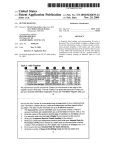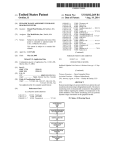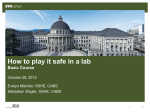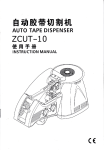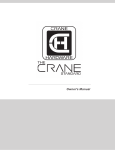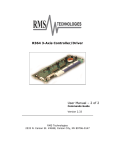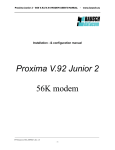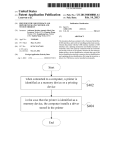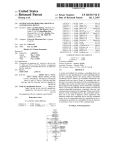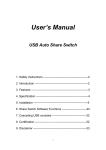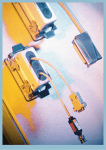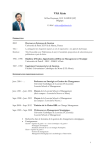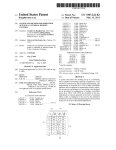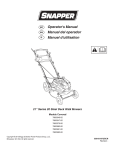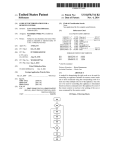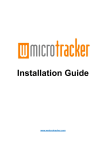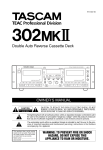Download Method of programming a universal remote control
Transcript
US008378875B2
(12) United States Patent
D’Hoore et a].
(54)
US 8,378,875 B2
(10) Patent N0.:
(45) Date of Patent:
METHOD OF PROGRAMMING A
(56)
Feb. 19, 2013
References Cited
UNIVERSAL REMOTE CONTROL
( )
75
U.S. PATENT DOCUMENTS
Inventors: Michael Walter Paul D’Hoore,
Korbeek-Dijle (BE); Juergen Forscht,
2
Nanolstadt (DE); Rogier Louis Jacques
6,344,817 B 1
Willem Thissen, Leuven (BE)
6,774,813 B2
2003/0141987 A1*
ghciiggegtzttél'
2/2002 VerZulli
8/2004 Van Ee et a1.
7/2003
Hayes .................... .. 340/825.72
(73)
Assignee: Koninklijke Philips Electronics N.V.,
Eindhoven (NL)
2003/0189509 A1 * 10/2003 Hayes et a1~ ~~~~~~~~~~~~~~~~ ~~ 341/176
2004/0257239 A1
12/2004 Gr1esau et a1.
(*)
Notice:
WO
0243022 A2
5/2002
(21)
Appl. N0.:
12/282,692
WO
03083801 A2
10/2003
(22)
PCT Filed:
Mar. 5, 2007
* “ted by exammer
(86)
PCT N0.:
PCT/IB2007/050714
Pr’mry Examlw * Don N V0
§ 371 (0)0),
(57)
(87)
(2)’ (4) Date'
Mar‘ 6’ 2009
PCT Pub NO; W02007/105142
A method for setting up a Remote Control is described. In one
step (1) a con?guration mode is entered. In another step an
identi?er entry is accepted (3). In case that the identi?er is a
brand-id the remote control scans though code-sets corre
2005/0144562 A1*
Subject to any disclaimer, the term of this
patent is extended or adjusted under 35
U-S-C- 154(1)) by 1012 days-
PCT Pub‘ Date: sep‘ 20’ 2007
_
(65)
(30)
_
_
6/2005
Schena et a1. ............... .. 715/741
2006/0089118 A1
4/2006 Whltehouse
FOREIGN PATENT DOCUMENTS
WO
0070577 A1 11/2000
ABSTRACT
sponding to the brand by sending a remote control signal (7),
Pnor Pubhcatlon Data
US 2009/0237287 A1
Sep. 24, 2009
checking for a user reaction (8), testing further remote control
signals of a user selected code-set (9) and checking for a user
approval of the selected code-set (10) and Wherein the step of
Foreign Application Priority Data
scanning is repeated until a user approval is entered. Lastly
the remote control installs the user approved code-set (13). In
Mar. 15, 2006
(EP) ................................... .. 06111201
ease that the identi?er is a eede_set_id the remote eehtrel
(52)
Int‘ Cl‘
H041‘ 17/02
(200601)
G05B 11/01
(200601)
US. Cl. .................... .. 341/176; 348/734; 340/1228
sends a remote control signal of the corresponding code-set
(7), checks for a user reaction (8), tests further remote control
signals of the code-set (9) and checks for a user approval of
the code-set Moreover the invention describes a Remote Con
trel that is Capable of performing the previously deserihed
(58)
Field of Classi?cation Search ................ .. 341/176;
Steps,
(51)
340/4.11, 12.23, 12.28; 348/114
See application ?le for complete search history.
15 Claims, 5 Drawing Sheets
1 STAR7 CONF‘GURA'UON MODE
1
SELECT DEVICE-TYPE TO SETUP THE uRc FOR.
ENTER DENTIFIER ON THE um:
4 START THE ‘SCANNING’ PROCESS
5 “RC DETERMINES THE coos-ssrs TO WEMTE THROUGH,
6 ITERATE THRO UGH ALL 00055575.
URC SENOS A SPECIFIC (or "1010012 speci?c;
‘7 1R-FUNCT1ONS PER CODE-BET
Does the
RIB/anon 01 12
Codese‘s
ALGQRWHM
STOPS
WITHOUT
INSTALUNG A
CODE-SET.
-
15
ALGORJTHM STOPS AND
USER-APPROVED
14 CQDESET 1s INSTALLED.
US. Patent
Feb. 19, 2013
Sheet 1 015
TV
US 8,378,875 B2
DVD
Philips: 0392, 1253, 5547,
2236,
4587, 4566,
Sanyo: 5661
Sony: 0023, 0024, 2566,
5689, 6588
4456
Philco: 5689, 4566
FIG. 1
Philips
9375
Samsung
9973
Pioneer
9376
Sony
9876
FIG. 2
US. Patent
Feb. 19, 2013
Sheet 2 0f 5
US 8,378,875 B2
TV
9375 =phi'ips
0392, 1253, 5547, 2236, 4587, 4566, 5689, 6588
TV
9376 =P‘°"ee’
5697, 4566, 4567, 4588, 6994, 0122
TV
9876 =5°“Y
0036, 4563, 5642
DVD
9375 =phi'ips
6545, 6653, 7564
DVD
9973 =samsung 1212, 0126, 4456, 3365
DVD
9876 =S°“Y
Philips
9375 (an actual pointer to a
0023, 0024, 2566, 4456
Samsung
list of codesets)
Phil co
9973 (an actual pointer to a
list of codesets)
5689 (a single codeset-id)
Pioneer 9376 (an actual pointer to a
sanyo
5661 (a single codeset-id)
Sony
9876 (an actual pointer to a
list of codesets)
list of codesets)
FIG. 4
US. Patent
Feb. 19, 2013
Sheet 3 0f 5
US 8,378,875 B2
f1 START CONFTGURATTON MQDE.
‘If
"f2
SELECT DEvTcE-TYPE TO SETUP THE URC FOR.
U
"/3
"
ENTER iDENTiFiER ON THE URC.
START THE "SCANNSNG" PROCESS.
‘I!’
[05 HRS DETERMENES THE CQEE-EETS TO ETERATE THROUGH.
"
»f
‘F
6 ITERATE THROUGH ALE. CUBE-SETS.
URC SENSE A SPECTFEC (or multipie speci?c)
;, iR-FUNCTEONS FER com-SET.
_ x”
9
u--*8’
8Y
‘j
User Offered to
try U RC buitonE
Reaction
1
11 iTERATiON THROUGH ALL CODE-SETS
FNESHED?
Select a “2"d Levei" Set of
[2093 the
iteration of
Cede-Sets
Beiong tn) a
v
Cnde-Seis and Re~Start
)'
iteraiiens.
l
"1ST Levei"
lteraticm?
STOPS
WETHOUT
iNSTALLENG A
CODE-SET.
“P15
ALGG‘RFTH M STQPES AN D
USER-APPROVED
“W14 CODE-SET IS ENSTALLEDK
FIG. 5
US. Patent
Feb. 19, 2013
_
w{NF}.
l‘
Sheet 4 of5
US 8,378,875 B2
START THE SETHUF’ PROCESS.
DETERMENE WHAT CQDESETFS MAY
MMKFB WORK WETH THE USER’S DEVECE
&
ETERATE THROUGH A NEXT
“r94 CODESET X, where X ranges from 1 ‘(a N.
------i-
‘m
'
/ For each Code-Set, send one
a!" friars iR»Ccde(s) and wait
for user to have a chance to
“r75
react.
Keys thai previousiy were (i) not
assaciated with an iR-Gcrde 0;‘ (ii)
indicated t0 be associated with nan
r7 a? working iR- COGEES, wil! be asscsciated
with ER~Cc2des ‘from the curreni
seiected Code~3et
5
USE!‘ tests if keys on URC
'78 wurk as expected.
Aigarithm instaiis iR-Codes
User indicate
a my works?
FIG. 6
from (me or mare
iR-CQdQ-SMS and Stops.
US. Patent
Feb. 19, 2013
__
_
‘
_
Sheet 5 of5
_
I,
KLYBUARU
PRQQESSQR
t
(
4G
US 8,378,875 B2
ER or RF
Transmitter
1
30M"
(
‘
5G
( including
Database ,3
2G
REMOTE
I 7
CONTROL
US 8,378,875 B2
1
2
METHOD OF PROGRAMMING A
UNIVERSAL REMOTE CONTROL
continuing auto-scan When it ?nds a sub-optimal code-set, i.e.
BACKGROUND OF THE INVENTION
some functions/codes are missing or not Working properly, is
tedious.
The methods 1 and 2 are disclosed in U.S. Pat. No. 6,344,
1. Technical Field
The present invention generally relates to a Universal
remote control (URC). Moreover the present invention relates
to a method of programming an URC, e.g., by using brand
and code-set identi?ers.
3. Brand-search (further referred to as method 3).
Using Brand-search the user has to enter a brand-id (in
stead of a code-set-id) and choose the device-type he Wants to
?nd IR-codes for. There is a ‘magic’ key-press to start this
procedure. Then the user types the ID of the brand of his CE
8l7 Bl .
2. Description of Related Art
equipment and presses the device-button (TV, DVD, Sat,
Multiple Ways exist hoW a user can con?gure a Universal
AMP). Then an auto-scan starts, but only for the code-sets for
that certain brand (not for all brands as in auto-scan).
The main advantage is that this is a lot quicker then auto
Remote Control (URC) or another device With URC func
tionality to Work With his CE equipment (like TV, Amps,
DVD-players, . . . ). Most URCs actually offer a multitude of
scan. The draWback is that a manual is needed to look up the
Ways to do this. The goal of all these methods is to help the
user to easily ?nd the best-matching ‘IR code-set’ (set of IR
codes) for the URC to control the CE equipment. Finding that
best-matching code-set is not easy due to the high number of
possible code-sets for a certain Brand/Device combination.
Eg for Philips TVs a user has to pick one oflO-l 5 code-sets.
The most popular Ways of con?guring that URC are listed
brand-ids, although it is briefer than the manual needed for
method 1. Another big draWback is that for all brands the
URC needs to keep a reference to all the code-sets for a certain
brand/device-type combination. This consumes a lot of stor
20
supported for this mechanism. If the right brand is not in this
beloW. All have drawbacks as described.
1. Enter a code-set from the manual (further referred to as
method 1).
25
The user uses the manual to look up a combination of
Brand and Device-type (e.g. TV, DVD, . . . ). It is possible that
the universal aspect of the remote is limited to just one
Device-type, often TV. There he ?nds a list of code-set-ids he
needs to punch in on his URC. Often these code-set-ids con
age space. For that reason often only the bigger brands are
list, the user is referred to method 1 or 2. As explained herein
above, in case of method 1, a bigger manual is needed. Also
the user has to try multiple methods that all Work different and
therefore needs to read through many pages of the manual
before he successfully can con?gure his URC. The user has to
select the correct method to be used, Which may be confusing.
Another disadvantage is that brands that are not in the list
30
sist of 3 to 5 digits (seemingly random). Before entering the
of supported-brands Will never Work. Users Will have to revert
to method 1. FIG. 2 shoWs a part of the manual that the user
uses to look up the brand-ids. This table is much shorter than
?rst code-set-id, the user needs to press some ‘magic’ com
the table for method 1, since it only contains the brand-ids for
bination of keys (or a special) key to go to programming
the top brands. The Philco and Sanyo brands are not in here to
save space on the URC’s storage. Inside this storage there is
another table that links the brand-ids per device-type to the
list of code-sets that brand-search Will iterate through. This is
shoWn in FIG. 3. Brands that are introduced after the produc
tion of the remote Will never be covered using brand-search.
When neW brands appear on the market, a softWare update of
mode. After having entered the ?rst code-set-id, the user can
try out the codes of the installed IR code-set to verify if that
Works on his CE equipment. If the user isn’t happy (since
some codes are not Working, or he sent the Wrong code), he
35
can use the programming mechanism to enter another code
set-id and try again.
The main draWback of this scenario is that it’s tedious for
40
the URC is needed. Also in case there is a neW code-set-id for
a user to enter the code-set-id digits and try to ?nd a code-set
a given brand/device-type combination brand search does not
that Works. Many Will not have any effect on the equipment at
all. Also this requires a pretty extensive list, that contains all
combinations of Brand/Device-types and their list of code
Work. Furthermore, brand-search assumes all brand and cor
set-ids to be tried. This list may be in a manual or on a Web site 45
in the case that users get Web support. The above is illustrated
in FIG. 1 that shoWs part of the URC’s manual that a user uses
to look-up the Code-set-ids for the Brand/Device-type com
binations.
2.Auto-scan (also knoWn as auto-search, further referred to as
for a URC that is easy for a user.
SUMMARY OF THE INVENTION
50
method 2)
According to an aspect of the invention, a method is pro
vided for setting up a Remote Control. It comprises the steps
of: entering a con?guration mode, accepting an identi?er
Auto-scan makes it simpler for a user to ?nd a code-set that
Works. Here the user presses another ‘magic combination of
keys’, optionally selects the device-type he Wants to search
for (i.e. By pressing the ‘TV’, or ‘DVD’ button on his URC).
responding brand-ids are ?xed.
It is an object of the invention to provide a URC With an
easy setup While requiring limited memory resources. More
over it is an object of the invention to provide a setup method
entry, and scanning though remote control code-sets. The step
55
of scanning comprises: in case that the identi?er entry is a
Then he presses a key to start auto-scan. In some variants he
brand-identi?er, iterating through the remote control code
has to keep a certain button pressed. The URC starts iterating
sets corresponding to the brand and testing said remote con
trol code-sets, and in case that the identi?er-entry is a code
set-identi?er: testing the remote control code-set
through all code-sets for the selected device and sends one or
more IR-functions in the code-set (often PoWer-toggle or
PoWer-off) to the equipment. As soon as the CE device reacts
(by either turning off, on, or any other response to the IR-code
sent), the user presses a button (or releases a button he Was
holding). NoW he can try if the other keys Work as Well, or
have a mechanism to restart auto-scan trying to ?nd another
code-set that Works better.
The main draWback of this auto-scan it that it can take a
long time for the URC to ?nd a Working code-set. Also
60
corresponding to the code-set-identi?er.
This alloWs making the con?guration of a URC simpler for
a user. At the same time it makes producing the so created
simpler URC cheaper for the manufacturer because there is
65
no additional need for electronic storage and the instructions
for use (e. g. manual) can be kept a lot smaller.
The main improvement is to combine the ‘Brand-id’ (as
used in the Brand-search method) With the ‘Code-set-id’ (as
US 8,378,875 B2
3
4
used in the ‘manual code-set-id selection’ method). To the
a Wild card (e. g. “0000”) may be selected that Will scan
through all code sets. Preferably, the code sets of minor
brands With the highest likelihood are ?rst scanned through.
user all these ids appear to be ‘Brand-ids’; some of these ids
are actual Brand-ids (referring to a pre-programmed list of
code-set-ids for a certain brand/device-type combination);
According to a further embodiment the use of a numerical
others are actual code-set-ids. For brands/device-type com
keyboard for entering a brand-identi?er comprising letters is
binations that have only a loW number of code-sets, or the ?rst
code-set has a very high success-rate, the user Will punch in
the code-set-id directly. This means there is no additional
memory usage for making a pointer from a brand-id to code
set-ids. In technical terms the notion of code-set-ids and
brand-ids still exists, but this is made invisible to the user.
enabled. This brand identi?er preferably is the name of the
brand. In this Way, the user can Write the brand-identi?er by
means of the numerical keyboard of the remote control in the
There might be a numbering convention to distinguish
betWeen brand-ids and code-set-ids (eg all brand-ids start
With 8 or 9).
The method according to the present invention has numer
ous advantages:
prehensible Way of entering the brand identi?er.
same Way as Writing SMS-messages using the numerical
keyboard of his mobile phone. Since most users have expe
rience in Writing SMS-messages, this results in a very com
According to a further aspect of the invention another
method for setting up a Remote Control is provided. It com
prises the steps of: entering a con?guration mode, scanning
though remote control code-sets, testing if individuals keys of
a code set send correct codes and receiving user-feedback on
Within the same memory constraints, the Brand- search can
be extended to ALL brands, not a small subset of popular
brands.
It is easier for a user, since there is no fallback scenario
from Brand-search to Auto-scan or manual Code-set-id selec
20
tion needed, anymore.
a number of remote control code-sets are combined into a
single remote control code-set. The single remote control
There is no need for an extensive manual as needed for the
Code-set-id selection method (method 1). It makes con?gu
ration of URC functionality easier for users.
the correct and/or incorrect Working of the tested keys, replac
ing non-Working codes by codes from at least a further remote
control code-set, combining codes from the remote control
code-sets and storing them for use by the remote control. So,
25
In the method according to the invention by only changing
the instructions for use, almost all brands can be supported. In
code-set is installed in the remote control. This is very prac
tical if there are multiple code-sets that trigger a reaction on
the equipment to be controlled but also comprise a feW codes
that do not Work.
case that a neW brand appears, the instructions for use should
According to an embodiment codes from the same remote
re?ect this neW brand by means of the code-set-id of the basic
control code-set are assigned to keys belonging to a certain
key-group. In practice it is very likely that if one key of a
IR-code-set that it uses. To the user this code-set-id appears to
be the brand-id of the neW brand. This assumes that this basic
30
certain keygroup Works, all keys Will Work if their functions
IR-code-set is already in the IR-Database (Which is often the
case).
According to an embodiment of the invention, the iteration
through remote control code-sets corresponding to the brand
35
continues until a user approval of a remote control code-set is
entered or until all the remote control code-sets correspond
ing to the brand have been tested. In this Way, the success rate
of ?nding a Working remote control code-set for the brand is
made as high as possible. If the user approves of a certain
remote control code-set, it is installed into the remote control.
example, if the user feeds-back that a certain button is or isn’t
Working, this information can be used to remove codesets
40
Preferably, the step of testing a remote control code-set
comprises the steps of: sending a remote control signal of the
remote control code-set (preferably poWer toggle or poWer
on/off), checking for a user reaction, and in case of a user
control is provided comprising memory means storing brand
45
for the remote control code-set. So, ?rst a limited test of the
code-set is performed sending one or a feW codes. If this/these
50
in case that the identi?er-entry is a code-set-identi?er:
substantially reducing the time of the scanning process.
60
testing the remote control code-set corresponding to
the code-set-identi?er.
65
a remote control is provided comprising
means for entering a con?guration mode:
means for scanning though remote control code-sets,
means for testing if individuals keys of a code set send
initiated by this method doesn’t result in a Working URC, the
programming of the URC Will automatically go to a further
In order to shorten the user manual by taking out the minor
brands, or to alloW neW brand names With existing codes sets,
iterating through the remote control code-sets corre
sponding to the brand and testing said remote control
code-sets,
can be limited to code-sets for a certain device type, thereby
scanning step Where the remotes iterates through all ‘back
up’ code-sets for the selected device-type, if no Working
code-set Was found during the ?rst scanning step.
means for entering a con?guration mode,
means for accepting an identi?er-entry,
means for scanning though remote control code-sets
Wherein the means for scanning are adapted for:
in case that the identi?er entry is a brand-identi?er,
55
tion, a device type entry is accepted. In this Way, the scanning
Because there is a small possibility that the brand-search
identi?ers pointing to a list of code set-identi?ers for the
brand and storing single code set-identi?ers Which are not
pointed to by a brand-identi?er.
According to a still further aspect of the invention a remote
control is provided comprising:
code(s) Work correctly, the user reacts, for example by press
correctly. For the other code-sets no full test has to be per
formed.
According to a further preferred embodiment of the inven
from the set of codesets that haven’t been iterated through,
yet. This Will speed up the set-up of the remote.
Preferably, the method according to the invention is imple
mented by means of a computer program.
According to a further aspect of the invention a remote
reaction, enabling the user to test keys of the Remote Control
ing a key of the remote control. He is then given the oppor
tunity to test also the other codes. This Way of testing is very
e?icient, because the user only has to perform an extensive
test for the code-sets for Which the ?rst code(s) Worked,
are taken from the same IR-codeset. This Will speed up the
set-up of the remote.
According to a further embodiment based on the testing
step the user-feedback is used to limit or extend the set of
remote control code-sets that are scanned through. For
According to a still further a further aspect of the invention
correct codes and receiving user-feedback on the correct
and/or incorrect Working of the tested keys,
US 8,378,875 B2
6
5
means for replacing non-Working codes by codes from at
Steps to Con?gure a URC Using a Preferred Method of the
Invention.
least a further remote control code-set,
means for combining codes from the remote control code
sets and storing them for use by the remote control.
The User Interaction can resemble a typical Brand-search
approach. The steps are shoWn in FIG. 5 and may actually be
in a different order in different embodiments. The different
steps are described beloW.
BRIEF DESCRIPTION OF THE DRAWINGS
The user starts the con?guration mode of the URC (step 1).
The invention Will be better understood and its numerous
There may be different mechanisms to do this, such as press
ing a setup-key for a longer time, or by means of a ‘magic’
objects and advantages Will become more apparent to those
skilled in the art by reference to the following draWing, in
key-press Where different buttons are pressed simultaneously.
conjunction With the accompanying speci?cation, in Which:
If the remote is universal for more than one Device-type,
the user selects the Device-type he Wants to setup the URC for
FIG. 1 shoWs entries for a code-set from a user manual
according to the prior art.
(step 2). This could be TV, VCR, DVD, Sat, Amp, . . . as
FIG. 2 shoWs a part of a manual that the useruses to look up
supported by the URC. This step is optional.
the brand-ids according to the prior art.
Alternatively, the device type is not selected and the scan
ning process described herein after includes code sets for all
device types for Which the URC is suitable. Note that this
FIG. 3 shoWs a table that links brand-ids per device-type to
a list of code-sets that a brand-search Will iterate through
according to the prior art.
FIG. 4 shoWs an example of a table With actual pointer to a
list of code-sets.
FIG. 5 shoWs steps to con?gure a URC using a preferred
method.
FIG. 6 shoWs steps to con?gure a URC using a further
20
The user looks up the Brand-id or the single code-set-id in
the instructions for use of the remote and enters it on the URC
(step 3). As explained herein above, to the user all these ids
preferred method.
FIG. 7 shoWs a block diagram of a remote control suitable
selection may be combined in step 1 if the magic key-press
contains the button for the device-type to be con?gured.
25
for implementing the present invention.
Throughout the ?gures like reference numerals refer to like
elements.
appear to be ‘Brand-ids’. Optionally a LED may be used to
con?rm the successful or unsuccessful acceptance of the
entered digits. Optionally there is an id to press if the Brand is
unknoWn or not in the list (eg 0000, a so called “Wild card”).
The user starts the ‘ scanning’ process (step 4). They may be
implemented by pressing a button on the URC or by pressing
DETAILED DESCRIPTION OF THE PRESENT
INVENTION
30
The URC determines the code-sets to iterate through (step
5). If the entered ID Was a pointer to a set of code-sets, the
softWare iterates through all these codesets (step 6). If the ID
The table of FIG. 4 shoWs an example of a table With actual
pointers to a list of code-sets. Ids starting With a 9, the brand
ids, (Philips, Pioneer, Samsung, Sony) are actually a pointer
& holding a button.
Was a speci?c Code-set-id only, the list Will only contain that
35
single Code-set and proceed (step 6). During the iteration, the
to a list of code-set-ids for a certain brand/device-type com
URC sends a speci?c (or multiple speci?c) IR-functions per
bination. All other ids (Philco, Sanyo) are actually single
code-set-ids. The digit convention is just to illustrate the
code-set (step 7). In step 8 it is checked if there is a user
reaction. If there is no user reaction, the algorithm Waits a
invention. For the user there is no difference betWeen the
brand-ids and the single code-set-ids, the URC’s softWare
40
handles the tWo different kinds of ids.
and a speci?c (or multiple speci?c) IR-functions is/are sent.
For Philips the softWare-algorithm Will look up the code
sets to use by using the brand-scan process in the softWare.
For Philco it Will only use Code-set-id 5689. Another Philco
code-set-id (4566) Will not be used since it is very unlikely to
be the correct code-set anyWay.
When there is a user reaction (by pressing a key or by releas
45
Another advantage of this approach is that because the
actual code-set-ids can be entered in the setup, it is possible
for the user to type in the correct code-set in one go. This
alloWs the support of brands that Were not in the brand-list at
the time the remote Was produced, but use a code-set that is
already available in the Database. In that case the instructions
for use should be amended accordingly or the helpdesk could
50
instruct the user Which ID to enter. In case that a neW brand
appears, the instructions for use should re?ect this neW brand
certain time. Then it is checked if the iteration through the
code-sets is ?nished (step 11). If this is not the case the
iteration is continued (step 6). The next code-set is retrieved
55
ing the pressed key) or When the last IR-code is sent, the
iteration stops.
If the user reacted, he is (optionally) offered to try the
buttons of the URC for the selected code-set (step 9). Steps 7,
8 and 9 together form the step of testing said remote control
code-sets.
In step 1 0 the user indicates if he accepts the current remote
control code-set or not. If the user accepts, then the algorithm
stops and the user approved code-set is installed (step 14). If
the user doesn’t accept, the scanning process is continued by
going to step 11.
In step 12 the algorithm checks if the iteration, that Was
by means of the code-set-id of the basic IR-code-set that it
?nished in step 11, Was an iteration of code sets belonging to
uses. To the user this code-set-id appears to be the brand-id of
the neW brand. This assumes that this basic IR-code-set is
a brand (“?rst level” iteration). If so, the algorithm proceeds
already in the IR-Database (Which is often the case).
The instructions for use may be in the form of a paper
manual or in electronic form for example on a user support
60
‘second-level’ set could for instance consist of a list contain
ing 1) all Brands for the device-type and/ or 2) a list of back-up
code-sets knoWn to be likely candidates. Then the algorithm
Web site.
This approach Works best if the remote control is universal
for only one device-type (i.e. TV), Which is the majority. In
other cases a different brand-list should be present in the
instructions for use for each device-type. Alternatively, a
single list could be used for all device types.
to step 13. This means that no code-set Was found by iterating
through the available code-sets. In step 13 a “second-level”
set of code sets is selected and the iteration is re-started. This
continues With this neW list to iterate through at step 6.
65
If in step 12 the algorithm determines that the iteration, that
Was ?nished in step 11, Was a second-level iteration, the
algorithm stops Without installing a code-set (step 15).
US 8,378,875 B2
7
8
Alternative Embodiments
In a different embodiment, the invention may be used to
What IR-codes are actually sent-out depend on the
progress in the algorithm. It may be a precon?gured IR-code
set-up the URC-functionally of a set-top box, PVR, . . . . This
or an IR-code for Which the user indicated that it didn’t Work
may happen When the set-top-box controls other devices like
(see step 78).
a Satellite or cable receiver.
6. The algorithm checks for a user reaction (indicating a
sent IR-code triggers some function on the target device).
Instead of IR-codes, the idea can also be applied to RF
codes.
This reaction is often the press (or release) of a key (step 76).
SMS-Keyboard Entry of the Brand
When the user doesn’t react, the algorithm continues at
step 74. When the user does react, the algorithm continues at
In the description above, the Brand-id is represented as an
x-digit code (x:4 in the examples). This alWays requires
step 77.
7. Assume that code-set i is selected. Keys that previously
lookup in the manual. To make it even easier the SMS-key
board can be used instead. On a GSM phone the ‘2’ key also
has the letters ‘ABC’ assigned, ‘3’ has ‘DEF’. The SMS
keyboard is a Way to compose Words using the numerical
Weren’t associated With an IR-code or Were indicated to be
associated With non-Working IR-codes, Will be associated
With IR-codes from code-set i (Step 77).
keypad as found on phones. Because on remotes the same
8. The user can noW try pressing the keys on the URC to test
‘keyboard’ is used (so these letters are also printed on the digit
if they Work as expected (step 78). He has means to indicate
Whether the keys function correctly or not.
keys), it is possible to perform similar composing.
Assuming the ‘single-tap’ SMS keyboard, one can spell ‘P
H I L I P S’ as: ‘7445477’ (so each digit once), Sony becomes
‘7669’, etc. Alternatively, the use of ‘multi-tap’ is possible:
PHILIPS becomes ‘7 44 444 555 444 7 7777’. (3 taps ofthe
7 key generate the 3-rd letter R (the 7 key also refers to
In different embodiments the Way to indicate that differs. In
20
ments the user can, after pressing a key, press a thumbs-up or
thumbs-doWn key to indicate if the previous key sent the
PQRS). LED-lights may be used to communicate a user that
the entry of a brand Was successful or not. Whether to use 25
single-tap, multi-tap or any other variation is not relevant for
the present invention.
Any number of digits is alloWed, but it’s possible to cap the
maximum number of digits. In case of overlap (tWo different
brands result in the same digit-sequence), a resolution can be
to concatenate the list of Code-sets for both brands and iterate
correct command. Or alternatively, each key has a green and
red backlight. Red means that the key doesn’t Work, green
means that it does. Many alternatives can be conceived of.
If the user is happy With the result, he can choose to end the
algorithm and store the current code-sets. (step 80).
30
9. The algorithm determines if the user indicated if a key
doesn’t Work (step 79). If the user indeed indicates a key
doesn’t Work continue at step 74 (noW taking into account the
user’s feedback for Working and non-Working keys), other
through these all in the scan process.
The SMS-keyboard entry of the brand may be used With the
Wise return to step 78.
method as described With reference to FIG. 5 but also With the
prior art method Brand-search (method 3).
a preferred embodiment the algorithm assumes all keys Work
OK unless the user keeps the key pressed. In other embodi
35
10. When the user is satis?ed With all keys after step 77, the
algorithm stops (step 80). It installs IR-codes from one or
Combine IR Codes from Different Code-Sets During the
more IR-codesets.
Scan Process.
Optionally, the user can indicate that he’s still not happy
With the current results and Wants to start from scratch. In that
case the user can jump to step 73 after indicating this.
Often, the scanning process Will ?nd multiple code-sets
that trigger a reaction on the CE equipment. This is because
there can be overlap betWeen multiple code-sets. I.e. for code
set X the PoWer, digits and Teletext Works ok, but volume
does not, While for code-setY the PoWer, digits and volume
Work but Teletext does not. In this case it’s very practical
When a user can indicate for a given matching code-set Which
codes do Work and/or Which codes do not. The URC can track
40
45
this and combine the Working codes of multiple code-sets into
a neW ‘custom con?guration’ code set, Which contains func
tions from multiple code-sets.
The scanning process is depicted in the ?owchart shoWn in
FIG. 6:
In an alternative embodiment of this algorithm, key-groups
are taken into account. This means that all keys that logically
belong together Will alWays be using IR-codes from the same
IR-codeset. For example, the volume keygroup consists of
‘volume up’, ‘volume doWn’ and ‘mute’. The teletext key
group consists of all keys controlling teletext modes, the
digits keygroup consists of all digits. In practice it is very
likely that if one key of a certain keygroup Works, all keys Will
Work if their functions are taken from the same IR-codeset.
50
1. Start the set-up process, e. g. by pressing the right
(magic) key (-combination).At this time none of the keys Will
have associated IR-codes (step 71).
2. Optionally select the device-type and optionally select
the brand (step 72). This can be done in either order and may
in practice be combined With step 71.
3. The algorithm determines What Code-sets may Work for
the user’s device. Suppose there are N different Code-sets
selected. These set of code-sets Will be iterated through, start
55
ing With the ?rst (step 73).
60
This Will speed up the set-up of the remote.
According to an alternative embodiment, the algorithm
may abandon the concept of the keygroups in the folloWing
situation: if the ?rst key of a keygroup Works but the second
(or subsequent) key of the key group does not Work. In that
case, the algorithm treats all keys in the keygroup, individu
ally Which means that the keys from the keygroup may use
codes from different IR-code sets.
It is also possible to use the given feedback in steps 77 and
78 to limit or extend current set of remote control codesets
While the algorithm is running. For example, When in step 78
When the users indicates so (by pressing (and holding) a
key) continue to next step.
the user feeds-back that a certain button is or isn’t Working,
this information can be used to remove codesets from the set
one or more IR-code(s) and Wait some time to give the user
of codesets that haven’t been iterated through yet. So if the
user Would indicate that the ‘volume up’ IR-code isn’t Work
ing the remote-control can omit trying another codeset With
that same IR-code for the volume up function. Also When the
user Would indicate that the ‘program doWn’ function Would
the chance to react (step 75).
be correct this information can be used.
4. The algorithm iterates through the next Code-set (step
74): Codeset x Where x ranges from 1 to N.
5. For each Code-set in the iteration, the algorithm sends
65
US 8,378,875 B2
10
The combination of IR codes from different code-sets may
be used With the method as described With reference to FIG.
in case of a user reaction, enabling, via the processor,
memory, and transmitter, to test keys of the Remote
Control for the remote control code-set.
5. The method according to claim 1, further comprising the
step of accepting, via the keyboard and processor, a device
5 but also With the prior art methods “Autoscan” (method 2)
and Brand-search (method 3).
FIG. 7 shoWs a block diagram of a remote control 20
suitable for implementing the present invention. Only the
type entry.
relevant components are shoWn. The remote control 20 com
prises a processor 30, a keyboard 40, an IR or RF transmitter
6. The method according to claim 1, Wherein if no user
approval of a remote control code set has been entered, via the
50 for transmitting control codes and a memory 60. The
keyboard, during the step of scanning, a further scanning step
is performed, scanning through further remote control code
invention is preferably implemented by a suitable computer
program stored in memory 60, Which is run by processor 30.
The brand-identi?ers and code-set identi?ers are also stored
in the memory 60.
enabling, via the processor and memory, the use of a numeri
As Will be recogniZed by those skilled in the art, the inno
vative concepts described in the present application can be
ters.
sets.
7. The method according to claim 1, further comprising
cal keyboard for entering a brand-identi?er comprising let
modi?ed and varied over a Wide range of applications.
Accordingly, the scope of patented subject matter should not
be limited to any of the speci?c exemplary teachings dis
cussed, but is instead de?ned by the folloWing claims. Any
reference signs in the claims shall not be construed as limiting
the scope.
20
8. The method according to claim 1, Wherein a numbering
convention is used to distinguish betWeen brand-identi?ers
and code-set-identi?ers.
9. The method according to claim 1, Wherein the identi?er
entry is a “Wild card” code, and upon detecting, via the pro
cessor and keyboard, that the “Wild car ” code is entered,
scanning further comprises iterating through all code sets for
The invention claimed is:
1. A method for setting up a Remote Control that includes
at least a device type.
10. A non-transitory computer-readable medium embod
a keyboard, a processor, a memory, and a transmitter, the 25 ied With a computer program that comprises computer pro
method comprising the steps of:
entering, via the keyboard and processor, a con?guration
gram code executable by a processor to perform the steps of
setting up a Remote Control of claim 1.
11. A method for setting up a Remote Control that includes
mode;
accepting, via the keyboard and processor, an identi?er
entry; and
scanning, via the processor and memory, though remote
control code-sets in a database stored in the memory of
the Remote Control, Wherein the step of scanning com
a keyboard, a processor, a memory, and a transmitter, the
30
mode;
scanning, via the processor and memory, though remote
prises:
in case that the identi?er-entry is a brand-identi?er that
control code-sets in a database stored in the memory of
35
identi?es a brand, (i) iterating, via the processor and
memory, through the remote control code-sets corre
sponding to the brand and (ii) testing said remote
control code-sets by sending, via the transmitter, to a
Consumer Electronic device for a given iteration, one
method comprising the steps of:
entering, via the keyboard and processor, a con?guration
the Remote Control;
testing, via the keyboard, if individuals keys of a code set
send, via the transmitter, correct codes and receiving, via
the keyboard, user-feedback on the correct and/or incor
40
rect Working of the tested keys;
replacing, via the processor and memory, non-Working
or more speci?c control code functions of a corre
codes With codes from at least a further remote control
sponding remote control code-set, and
code-set; and
combining, via the processor and memory, correct Working
in case that the identi?er-entry is a code-set-identi?er
that identi?es a single remote control code-set Which
in not pointed to by a brand-identi?er, testing the
single remote control code-set corresponding to the
code-set-identi?er by sending, via the transmitter, to
codes from the scanned remote control code-sets into a
45
codes of the neW custom con?guration code set for use
the Consumer Electronic device one or more speci?c
control code functions of the corresponding single
remote control code-set.
50
2. The method according to claim 1, Wherein the iteration
through remote control code-sets corresponding to the brand
for user approval of a remote control code-set and installing,
via the processor and memory, the user approved remote
control code-set for use by the Remote Control.
55
60
4. The method according to claim 1, Wherein the step of
testing a remote control code-set comprises the folloWing
user reaction; and
14. Remote Control comprising:
means for entering a con?guration mode;
means for accepting an identi?er-entry; and
means for scanning though remote control code-sets in a
database stored in a memory of the Remote Control
Wherein the means for scanning are adapted for:
in case that the identi?er-entry is a brand-identi?er that
identi?es a brand, (i) iterating through the remote con
trol code-sets corresponding to the brand and (ii) testing
steps:
sending, via the transmitter, a remote control signal of the
remote control code-set;
checking, via the processor, memory, and keyboard, for a
by the remote control.
12. The method according to claim 11, Where codes from
the same remote control code-set are assigned to keys belong
ing to a certain key-group.
13. The method according to claim 11, Where based on the
testing step, the user-feedback is used to limit or extend a
number of remote control code-sets that are scanned through.
continues (i) until a user approval of a remote control code-set
is entered, via the keyboard, or (ii) until all the remote control
code-sets corresponding to the brand have been tested.
3. The method according to claim 1, further comprising the
step of checking, via the processor, memory, and keyboard,
neW custom con?guration code set and installing, via the
processor and memory, the combined correct Working
65
said remote control code-sets by sending to a Consumer
Electronic device for a given iteration, one of more spe
ci?c control code functions of a corresponding remote
control code-set; and
US 8,378,875 B2
11
in case that the identi?er-entry is a code-set-identi?er that
identi?es a single remote control code-set Which is not
pointed to by a brand-identi?er, testing the single remote
control code-set corresponding to the code-set-identi?er
by sending to the Consumer Electronic device one or 5
more speci?c control code functions of the corresponding single remote control code-set.
12
means for testing if individuals keys of a code set send
correct codes and receiving user-feedback on the correct
and/or incorrect Working of the tested keys;
means for replacing non-Working codes With codes from at
least a further remote control code-set; and
means for combining correct Working codes from the
scanned remote control code-sets into a neW custom
15_ Remote Control Comprising;
con?guration code set and for installing the combined
means for enterin a con? uration mode;
g
g
10
means for scanning though remote control code-sets in a
code set for use by the remote control.
database stored in the memory of the Remote Control;
correct Working codes of the neW custom con?guration
*
*
*
*
*












